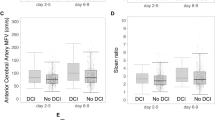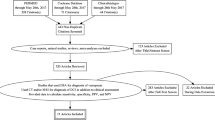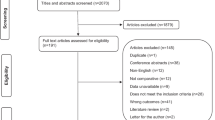Abstract
Background
Angiographic vasospasm after aneurysmal subarachnoid hemorrhage (aSAH) is associated with delayed cerebral ischemia (DCI)-related cerebral infarction (radiological DCI) and worsened neurological outcome. Transcranial Doppler (TCD) measurements of cerebral blood flow velocity are commonly used after aSAH to screen for vasospasm; however, their association with cerebral infarction is not well characterized. We sought to determine whether time-varying TCD-measured vasospasm severity is associated with cerebral infarction and investigate the performance characteristics of different time/severity cutoffs for predicting cerebral infarction.
Methods
We conducted a retrospective single-center cohort study of consecutive adult patients with aSAH with at least one TCD study between 2011 and 2020. The primary outcome was radiological DCI, defined as a cerebral infarction develo** at least 2 days after any surgical or endovascular intervention without an alternative cause. Cox proportional hazards models were used to examine associations between time-varying vasospasm severity and radiological DCI. Optimal TCD-based time/severity thresholds for predicting radiological DCI were then determined.
Results
Of 262 patients with aSAH who underwent TCD studies, 27 (10%) developed radiological DCI. Patients with radiological DCI had higher modified Fisher scale scores and trended toward earlier onset of vasospasm. Adjusted for age, Hunt and Hess scores, and modified Fisher scale scores, the worst-vessel vasospasm severity was associated with radiological DCI (adjusted hazard ratio 1.7 [95% confidence interval 1.1–2.4]). Vasospasm severity within a specific vessel was associated with risk of delayed infarction in the territory supplied by that vessel. Optimal discrimination of patients with radiological DCI was achieved with thresholds of mild vasospasm on days 4–5 or moderate vasospasm on days 6–9, with negative predictive values greater than 90% and positive predictive values near 20%.
Conclusions
TCD-measured vasospasm severity is associated with radiological DCI after aSAH. An early, mild TCD-based vasospasm severity threshold had a high negative predictive value, supporting its role as a screening tool to identify at-risk patients.




Similar content being viewed by others
References
Rabinstein AA, Weigand S, Atkinson JL, Wijdicks EF. Patterns of cerebral infarction in aneurysmal subarachnoid hemorrhage. Stroke. 2005;36:992–7.
Vergouwen MD, Ilodigwe D, Macdonald RL. Cerebral infarction after subarachnoid hemorrhage contributes to poor outcome by vasospasm-dependent and -independent effects. Stroke. 2011;42:924–9.
Crowley RW, Medel R, Dumont AS, et al. Angiographic vasospasm is strongly correlated with cerebral infarction after subarachnoid hemorrhage. Stroke. 2011;42:919–23.
Mizukami M, Takemae T, Tazawa T, Kawase T, Matsuzaki T. Value of computed tomography in the prediction of cerebral vasospasm after aneurysm rupture. Neurosurgery. 1980;7:583–6.
Fisher CM, Kistler JP, Davis JM. Relation of cerebral vasospasm to subarachnoid hemorrhage visualized by computerized tomographic scanning. Neurosurgery. 1980;6:1–9.
Brown RJ, Kumar A, Dhar R, Sampson TR, Diringer MN. The relationship between delayed infarcts and angiographic vasospasm after aneurysmal subarachnoid hemorrhage. Neurosurgery. 2013;72:702–7 (discussion 707–708).
Vora YY, Suarez-Almazor M, Steinke DE, Martin ML, Findlay JM. Role of transcranial Doppler monitoring in the diagnosis of cerebral vasospasm after subarachnoid hemorrhage. Neurosurgery. 1999;44:1237–47 (discussion 1247–1238).
Grosset DG, Straiton J, du Trevou M, Bullock R. Prediction of symptomatic vasospasm after subarachnoid hemorrhage by rapidly increasing transcranial Doppler velocity and cerebral blood flow changes. Stroke. 1992;23:674–9.
Kumar G, Shahripour RB, Harrigan MR. Vasospasm on transcranial Doppler is predictive of delayed cerebral ischemia in aneurysmal subarachnoid hemorrhage: a systematic review and meta-analysis. J Neurosurg. 2016;124:1257–64.
Alexandrov AV, Sloan MA, Tegeler CH, et al. Practice standards for transcranial Doppler (TCD) ultrasound. Part II. Clinical indications and expected outcomes. J Neuroimag. 2012;22:215–24.
Springborg JB, Frederiksen HJ, Eskesen V, Olsen NV. Trends in monitoring patients with aneurysmal subarachnoid haemorrhage. Br J Anaesth. 2005;94:259–70.
Luft AR, Buitrago MM, Torbey M, Bhardwaj A, Razumovsky A. Biphasic cerebral blood flow velocity profile in patients with aneurysmal subarachnoid hemorrhage. Neurocrit Care. 2004;1:455–9.
Carrera E, Schmidt JM, Oddo M, et al. Transcranial Doppler for predicting delayed cerebral ischemia after subarachnoid hemorrhage. Neurosurgery. 2009;65:316–23 (discussion 323–314).
Suarez JI, Qureshi AI, Yahia AB, et al. Symptomatic vasospasm diagnosis after subarachnoid hemorrhage: evaluation of transcranial Doppler ultrasound and cerebral angiography as related to compromised vascular distribution. Crit Care Med. 2002;30:1348–55.
Babikian VL, Wechsler LR. Transcranial doppler ultrasonography. St. Louis: Mosby-Year Book; 1999.
Sadan O, Waddel H, Moore R, et al. Does intrathecal nicardipine for cerebral vasospasm following subarachnoid hemorrhage correlate with reduced delayed cerebral ischemia? A retrospective propensity score-based analysis. J Neurosurg. 2021;2021:1–10.
Vergouwen MD, Vermeulen M, van Gijn J, et al. Definition of delayed cerebral ischemia after aneurysmal subarachnoid hemorrhage as an outcome event in clinical trials and observational studies: proposal of a multidisciplinary research group. Stroke. 2010;41:2391–5.
Weir B, Grace M, Hansen J, Rothberg C. Time course of vasospasm in man. J Neurosurg. 1978;48:173–8.
Etminan N, Vergouwen MD, Ilodigwe D, Macdonald RL. Effect of pharmaceutical treatment on vasospasm, delayed cerebral ischemia, and clinical outcome in patients with aneurysmal subarachnoid hemorrhage: a systematic review and meta-analysis. J Cereb Blood Flow Metab. 2011;31:1443–51.
Frontera JA, Fernandez A, Schmidt JM, et al. Defining vasospasm after subarachnoid hemorrhage: what is the most clinically relevant definition? Stroke. 2009;40:1963–8.
Funding
RWR was supported by a National Institutes of Health R25 (R25 NS065743) grant. SBS was supported by the American Academy of Neurology (CRTS 2020A013392).
Author information
Authors and Affiliations
Contributions
SBS: study conception/design, data cleaning and analysis, manuscript drafting and revision. IM: study conception/design, data cleaning, analysis, and interpretation, manuscript drafting and revision. SLL: data cleaning, analysis and interpretation, manuscript revision. MEM: data cleaning, analysis and interpretation, manuscript revision. RWR: data analysis and interpretation, manuscript revision. PMRL: study conception/design, manuscript revision. HV: study conception/design, manuscript revision. RD: study conception/design, data interpretation, manuscript drafting and revision. The final manuscript was approved by all authors.
Corresponding author
Ethics declarations
Conflicts of interest
SBS, IM, SLL, MEM, RWR, PMRL, and RD report no relevant disclosures. HV is employed by Marinus Pharmaceuticals.
Ethical approval/informed consent
This study was approved by the Mass General Brigham Institutional Review Board (protocol No. 2006P001829). Given that the data were deidentified, the requirement for patient consent was waived by the institutional review board.
Additional information
Publisher's Note
Springer Nature remains neutral with regard to jurisdictional claims in published maps and institutional affiliations.
Supplementary Information
Below is the link to the electronic supplementary material.
Rights and permissions
About this article
Cite this article
Snider, S.B., Migdady, I., LaRose, S.L. et al. Transcranial-Doppler-Measured Vasospasm Severity is Associated with Delayed Cerebral Infarction After Subarachnoid Hemorrhage. Neurocrit Care 36, 815–821 (2022). https://doi.org/10.1007/s12028-021-01382-2
Received:
Accepted:
Published:
Issue Date:
DOI: https://doi.org/10.1007/s12028-021-01382-2




